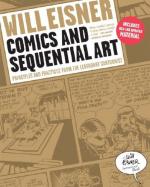
|
| Name: _________________________ | Period: ___________________ |
This test consists of 5 multiple choice questions, 5 short answer questions, and 10 short essay questions.
Multiple Choice Questions
1. What can give insight into a character's lifestyle and allow sociological observations?
(a) Posture and observation.
(b) Gesture and time.
(c) Posture and thought.
(d) Posture and gesture.
2. What does Eisner believe would happen if animals' faces were more flexible?
(a) Humans wouldn't kill animals.
(b) Humans would love animals.
(c) Humans would kill fewer.
(d) Humans would kill more.
3. What sweeping characteristic helps make the point of the artist and influence the reader/viewer?
(a) Narrow scope.
(b) Gestural timidity.
(c) Exaggeration.
(d) Broad scope.
4. What can artists be tempted to do to detract from the storyline?
(a) Hone the craft.
(b) Seize the day.
(c) Dazzle the eye.
(d) Sharpen the mind.
5. Who was the audience for early forms of sequential art?
(a) Broad audiences with no formal education.
(b) Kings and queens.
(c) The formally educated.
(d) Ministers and rabbis.
Short Answer Questions
1. What are gestures "almost idiomatic" to?
2. What must artist and writers risk?
3. In what time frame did comics assume the typical reader was a "10-year old from Iowa"?
4. What kind of stories have dominated the field of comics because of the limitations of the medium?
5. What do purely instructional comics often use to show relevance?
Short Essay Questions
1. Why are comic book artists frequently hired to produce storyboards for movie scripts and motion pictures?
2. Give a brief synopsis of Chapter 6.
3. Why does artwork dominate the reader's initial response?
4. Why do entertainment comics deny to the readers/viewers much of the freedom they would enjoy in pure prose?
5. Why are the body's gestures and postures stored in the artist's memory as a non-verbal vocabulary?
6. Why does Eisner reproduce the story written by Jules Feiffer that was never published?
7. Why do people make important daily judgments about faces?
8. Why is writing for comics most closely related to playwriting?
9. How has technology challenged the individuality of artists?
10. Why is teamwork often demanded by publishers?
|
This section contains 755 words (approx. 3 pages at 300 words per page) |

|




